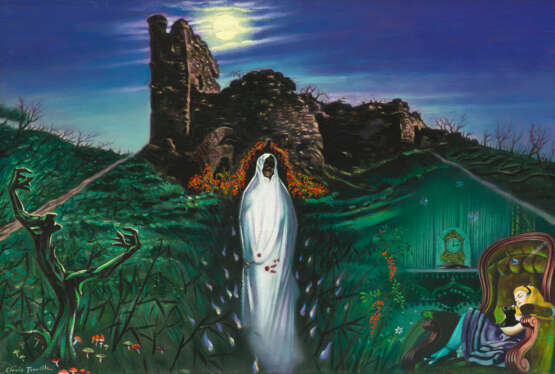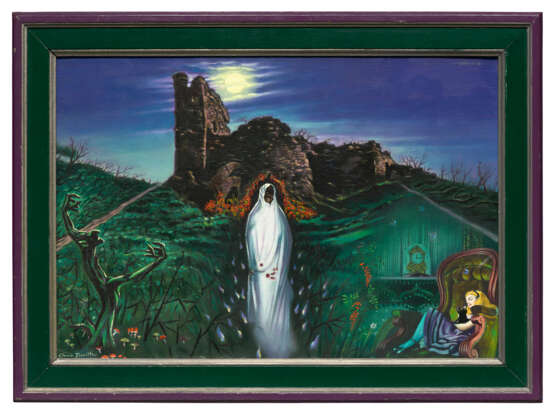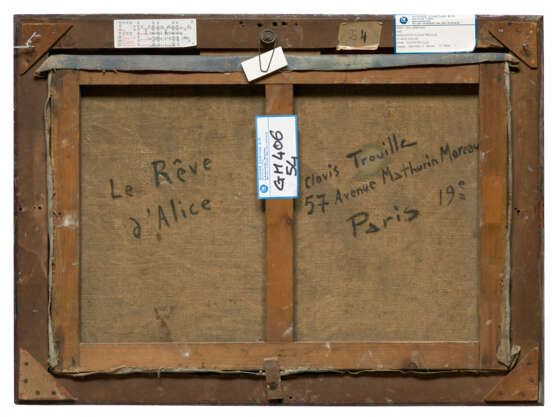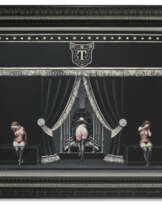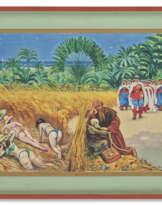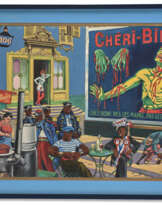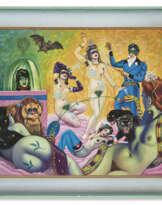ID 1400271
Lot 363 | Clovis Trouille (1889-1975)
Estimate value
€ 50 000 – 80 000
Le Rêve d'Alice (dans un fauteuil)
signé 'Clovis Trouille' (en bas à gauche), signé et inscrit 'Le Rêve d'Alice Clovis Trouille 57 Avenue Mathurin Moreau Paris 19e' (au revers)
huile sur toile dans son cadre d'artiste
Toile: 38 x 55.3 cm.
Cadre d'artiste: 47 x 63.6 cm.
Peint en 1945
signed 'Clovis Trouille' (lower left); signed and inscribed 'Le Rêve d'Alice Clovis Trouille 57 Avenue Mathurin Moreau Paris 19e' (on the reverse)
oil on canvas in its artist's frame
Canvas: 15 x 21 ¾ in.
Artist's frame: 18 ½ x 25 in.
Painted in 1945
Provenance
Atelier de l'artiste.
Puis par succession aux propriétaires actuels.
Literature
J.-M. Campagne, Clovis Trouille, Ivry, 1969, p. 67 (illustré).
R. Charmet et C. Trouille, Clovis Trouille, Paris, 1972, p. 44 (illustré en couleurs, p. 44-45).
C. Prévost, Parcours à travers l'œuvre de Clovis Trouille, Arles, 2003, p. 170 (illustré en couleurs; détail illustré en couleurs, p. 198).
Voyous, voyants, voyeurs, Autour de Clovis Trouille, cat. exp., Musée d'Art et d'Histoire Louis-Senlecq, Musée Arthur-Rimbaud et Musée du Vieux-Château, L'Isle-Adam, Charleville-Mézières et Laval, 2009, p. 49 (détails illustrés en couleurs).
Exhibited
Ostende, Museum voor Moderne Kunst, Clovis Trouille, mars-novembre 2002, no. 25.
Paris, Musée d'Art Moderne, Centre Georges Pompidou, Le Surréalisme d'abord et toujours, septembre 2024-janvier 2025, p. 229 (illustré en couleurs, p. 74).
Further details
Clovis Trouille est un artiste inclassable. Né en 1889 dans l’Aisne, il est admis à l’école des Beaux-Arts d’Amiens à 14 ans, où il se forme à la peinture, au dessin et au modelage. Il crée alors de nombreux paysages, des natures mortes et scènes d’intérieur, ou encore de spectaculaires vues de la cathédrale d’Amiens.
Mais deux épreuves façonnent la pensée de Trouille et changent son approche artistique à tout jamais. Son destin bascule tout d’abord lors de la Grande Guerre, où il est mobilisé dans le 110ème régiment d’artillerie lourde de 1914 à 1919. Il en ressort épuisé, traumatisé, les massacres auxquels il a assisté laissant une trace indélébile dans son esprit. Il ne retouchera un pinceau qu’en 1930.
Cependant, en 1932, sa fille Rachel meurt des suites d’une péritonite foudroyante. Le peintre, dévasté, frôle la folie ; sa peinture ne sera plus jamais pareille.
« Elle avait emporté avec elle, dans le tombeau, un lambeau de sa vie et son bonheur, puisqu’elle incarnait à ses yeux une sorte de perfection humaine. Il ne parlait d’elle qu’en disant : « Mon chef d’œuvre ». Avec cette mort d’une enfant tant aimée, le « cristal » de sa jeunesse s’était brisé. Ce sujet de douleur ne fut par la suite qu’à peine abordé par lui. Il avait emmuré sa peine. Sa peinture seule, comme il en avait décidé, parlerait pour lui seul. Les mots auraient sans doute trop irrité ses plaies, restées à vif ». Alice Lambert, fille de l’artiste.
Sa peinture prend un tout autre tournant, et rejette alors la morale de la société bourgeoise et l’imposture de la religion. Travaillant comme maquilleur professionnel de mannequins de cire, Trouille est salarié et a un revenu fixe, ce qui lui permet de ne jamais s’inquiéter de la manière dont pouvaient être perçues ses œuvres. Il travaille pour lui, retouche ses toiles indéfiniment et crée son langage scandaleux, blasphématoire, où tous les coups sont permis.
Ce discours le rapproche des Surréalistes, devenus partisans de toutes les dissidences depuis la parution du Manifeste du Surréalisme de Breton en 1924. Mais Trouille n’adhérera jamais vraiment au mouvement, préférant cultiver son indépendance artistique et tracer son chemin en marge des courants dominants.
100 ans plus tard pourtant, en 2024, lors de l’exposition Le Surréalisme d’abord et toujours, Le rêve d’Alice (dans un fauteuil) est exposé au Centre Georges Pompidou, démontrant l’importance de l’artiste dans la pensée surréaliste de l’époque.
Dans Le Rêve d’Alice (dans un fauteuil), on retrouve une silhouette fantomatique au premier plan, comme une Faucheuse drapée de blanc. Son voile est d’ailleurs tâché de sang. A gauche, l’arbre décharné est inspiré d’un souvenir de la guerre, les branches faisant écho aux mains crispées des soldats tombés sous les obus. La composition en triangle de la toile est cependant contrebalancée par cette Alice en bas à droite, dormant paisiblement, un chat dans ses bras. Son univers est doux, elle est sous terre, protégée. Des petits papillons volètent autour d’elle et on reconnait derrière elle l’emblématique pendule indiquant minuit et quart.
Au fond se détachent les ruines d’un château, sorti tout droit des contes de Perrault.
Dans toute cette peinture des éléments réveillent le décor, innocents et candides, comme sortis du rêve de la jeune fille. L’arbre décharné est entouré de petits champignons, la Faucheuse a une couronne de fleurs et des lucioles autour d’elle, au-dessus des ruines la lune s’échappe des nuages…
Le Rêve d’Alice (dans un fauteuil), est un exemple parfait de cette peinture inclassable de Trouille, se nourrissant de références culturelles, historiques et sociales, et s’entremêlant avec ses expériences personnelles et ses souvenirs intimes.
Clovis Trouille is an indefinable artist. Born in 1889 in the Aisne, he was admitted to the École des Beaux-Arts in Amiens at the age of 14, where he studied painting, drawing and modelling. He created numerous landscapes, still lifes and interior scenes, as well as spectacular views of Amiens Cathedral.
However, two events shaped Trouille's thinking and changed his artistic approach forever. Firstly, his destiny changed during the Great War, when he was called up to the 110th heavy artillery regiment from 1914 to 1919. He came out exhausted and traumatised, the massacres he witnessed left an indelible mark on his mind. He did not pick up a brush again until 1930.
However, in 1932, his daughter Rachel died suddenly of peritonitis. The painter, devastated, was on the verge of madness; his painting would never be the same again.
‘She had taken with her to the grave a shred of his life and his happiness, because in his eyes she embodied a kind of human perfection. He spoke of her only as ‘my masterpiece’. With the death of a much-loved child, the ‘crystal’ of his youth had shattered. The subject of his grief was scarcely broached by him afterwards. He had walled up his grief. His painting alone, as he had decided, would speak for itself. No doubt words would have irritated his raw wounds too much.’ Alice Lambert, the artist's daughter.
His painting took a completely different turn, rejecting the morality of bourgeois society and the imposture of religion. Working as a professional make-up artist for wax models, Trouille was employed and had a fixed income, which meant he never had to worry about how his work might be perceived. He worked for himself, retouching his canvases indefinitely and creating his own outrageous, blasphemous language, where no holds were barred.
This approach brought him closer to the Surrealists, who had become supporters of all forms of dissidence since the publication of Breton's Manifeste du Surréalisme in 1924. But Trouille never really joined the movement, preferring to cultivate his own artistic independence and carve out his own path on the fringes of the mainstream.
Yet 100 years later, in 2024, during the exhibition Le Surréalisme d'abord et toujours, Le rêve d'Alice (dans un fauteuil) was exhibited at the Centre Georges Pompidou, demonstrating the artist's importance in the Surrealist thinking of the time.
In Le rêve d'Alice (dans un fauteuil), there is a ghostly figure in the foreground, like a Grim Reaper draped in white. His veil is stained with blood. On the left, the gaunt tree is inspired by a memory of the war, the branches echoing the clenched hands of the soldiers who fell under the shells. The triangular composition of the canvas is counterbalanced, however, by Alice in the lower right, sleeping peacefully with a cat in her arms. Her world is soft, she is underground, protected. Small butterflies flutter around her, and behind her we can see the emblematic clock indicating a quarter past midnight.
In the background are the ruins of a castle, straight out of Perrault's fairy tales.
Throughout the painting, innocent and candid elements awaken the decor, as if they have emerged from the young girl's dream. The gaunt tree is surrounded by mushrooms, the Grim Reaperhas a crown of flowers and fireflies around him, and above the ruins the moon rises from the clouds...
Le Rêve d'Alice (dans un fauteuil) is a perfect example of Trouille's unclassifiable painting, taking inspirations on cultural, historical and social references and intertwining them with his personal experiences and intimate memories.
| Artist: | Clovis Trouille (1889 - 1975) |
|---|---|
| Applied technique: | Oil on canvas |
| Place of origin: | Western Europe, France, Europe |
| Auction house category: | Paintings, Watercolors, Drawings, Paintings |
| Artist: | Clovis Trouille (1889 - 1975) |
|---|---|
| Applied technique: | Oil on canvas |
| Place of origin: | Western Europe, France, Europe |
| Auction house category: | Paintings, Watercolors, Drawings, Paintings |
| Address of auction |
CHRISTIE'S 8 King Street, St. James's SW1Y 6QT London United Kingdom | |
|---|---|---|
| Preview |
| |
| Phone | +44 (0)20 7839 9060 | |
| Buyer Premium | see on Website | |
| Conditions of purchase | Conditions of purchase |
